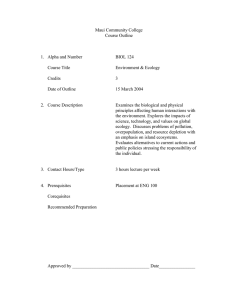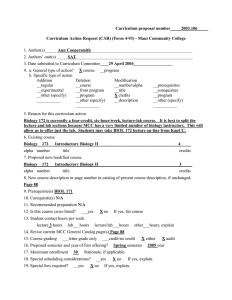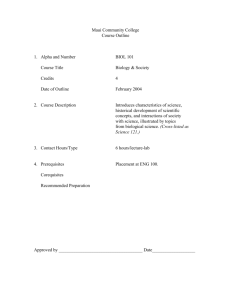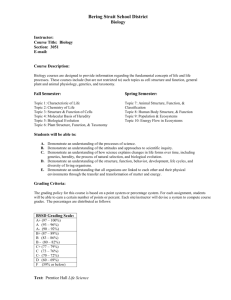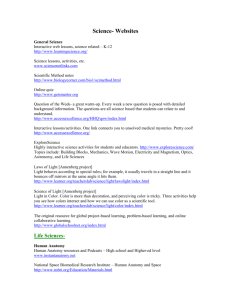Maui Community College
advertisement
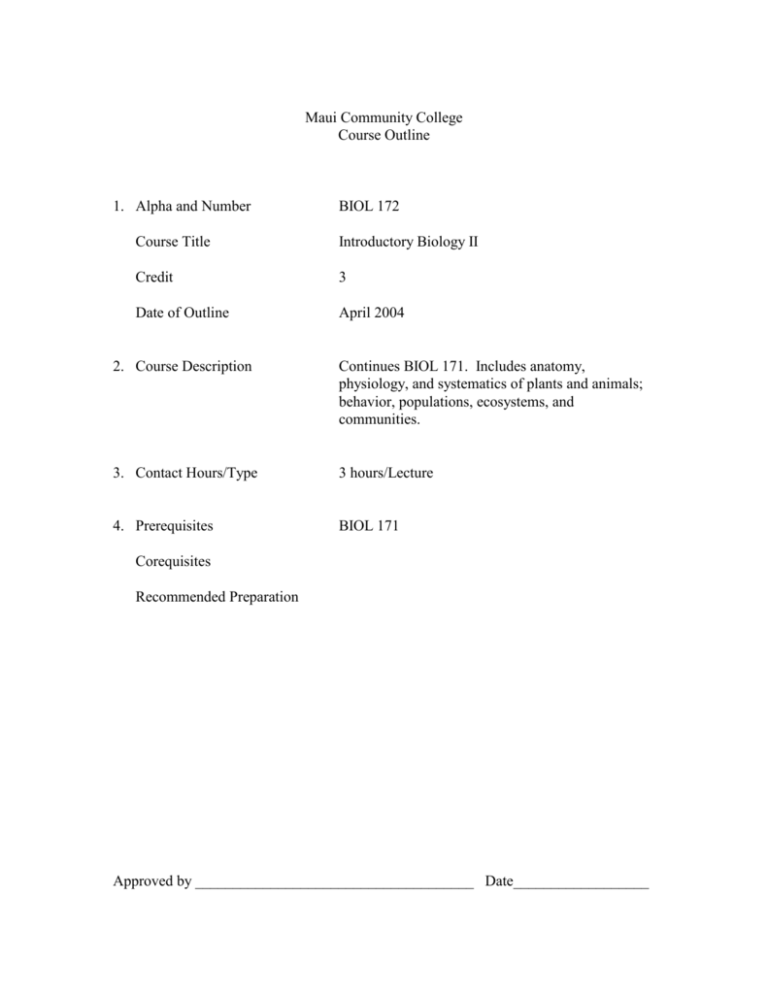
Maui Community College Course Outline 1. Alpha and Number BIOL 172 Course Title Introductory Biology II Credit 3 Date of Outline April 2004 2. Course Description Continues BIOL 171. Includes anatomy, physiology, and systematics of plants and animals; behavior, populations, ecosystems, and communities. 3. Contact Hours/Type 3 hours/Lecture 4. Prerequisites BIOL 171 Corequisites Recommended Preparation Approved by _____________________________________ Date__________________ 2 5. General Course Objectives Biology 172 provides life science majors with a comprehensive background in the concepts of biology. For detailed information on how this course focuses on the Maui Community College general education standards, see the attached curricular grid. Biology 172 fulfills the Maui Community College Natural Science requirement for the A.A. and A.S, degrees and the University of Hawai‘i at Manoa, General Education Requirements for Diversification, Natural Sciences, Biological Sciences (D/B; 3 credits). 6. Student Learning Outcomes For assessment purposes, these are linked to #7. Recommended Course Content. On successful completion of this course, students will be able to: a. explain the basic concepts of evolution, reproduction and development, transport systems, regulation and control mechanisms in plants; b. explain the basic concepts of evolution, support and movement, digestion and nutrition, respiration, circulation and immunity, homeostasis (thermoregulation, osmoregulation, and excretion), endocrine systems, neurons and nervous system, sexual reproduction, and development of animals; c. give examples of the diversity of plant and animal species including systematics and taxonomy; d. explain the principal concepts of animal behavior including evolutionary considerations, mechanisms of behavior, developmental behavior, and comparative animal behavior; e. explain and give examples of the principles of ecology including biosphere, biomes, communities, ecosystems, populations, and environmental interactions; f. discuss problems encountered in island ecosystems and methods for conservation of natural resources; g. discuss and provide supporting evidence for alternatives to current local environmental practices. 7. Recommended Course Content and Approximate Time Spent on Each Topic Linked to # 6. Student Learning Outcomes. 1-2 weeks Plant evolution and diversity (a, c) 1-2 weeks Plant morphology (a) 1-2 weeks Plant reproduction and development 3 1-2 weeks Transport mechanisms in plants (a) Regulation and control mechanisms in plants (a) 1-2 weeks Animal evolution and diversity (b, c) 1-2 weeks Animal digestion, nutrition, respiration, circulation, and immunity (b) 1-2 weeks Animal homeostasis (thermoregulation, osmoregulation, and excretion), and endocrine system (b) 1-2 weeks Animal sexual reproduction, development, and embryology (b) 1-2 weeks Neurons and the nervous-sensory system (b) 1-2 weeks Animal behavior: evolutionary considerations, mechanisms of behavior, developmental behavior, and comparative animal behavior (d) 1-2 weeks Ecology: populations, communities, ecosystems (e) 1-2 weeks Problems encountered in island ecosystems (f, g) Conservation of natural resources (f, g) 8. Text and Materials, Reference Materials, Auxiliary Materials and Content Text will be selected from the best and most up-to-date materials available, such as Campbell, Neil A. 2003. Biology, 5th edition, Benjamin Cummings Many books and videos are available for reference in the Biology office and in the MCC Library. Other resources materials include videos, reference books, periodicals, 35-mm slides, PowerPoint presentations, photographs, internet sites, biological specimens and slides, posters, brochures, CD-ROMs, and DVDs. 9. Recommended Course Requirements and Evaluation Specific course requirements are at the discretion of the instructor at the time the course is being offered. Suggested requirements might include, but are not limited to 10-90% Quizzes and tests 4 0-20% 0-20% 0-40% 0-50% 0-20% 0-8% 0-8% 0-8% 0-8% Reading notes, written discussion questions, vocabulary lists Problem sets Class discussion and participation Group work Projects, service-learning, case studies, problem-based learning Study groups Study logs Attendance Extra credit 10. Methods of Instruction Instructional methods will vary considerably with instructors. Specific methods will be at the discretion of the instructor teaching the course and might include, but are not limited to a. b. c. d. e. f. g. h. i. j. k. l. and tests with feedback and discussion; demonstrations and class discussions; case studies, investigative case-based learning, problem sets; narrated 35-mm slide shows, videos, and/or PowerPoint presentations; videos, DVDs, CD-ROMs with detailed viewing guide and discussion questions; small group activities; oral reports and other student presentations; homework assignments such as written assignments, reaction papers, observations, research notes, completing activities in study guides that accompany the text, web-based activities, reading text and reference materials, answering discussion questions, vocabulary lists; group and/ or individual research projects and reports; study logs and study groups; service-learning, community service, and/or civic engagement projects; and other contemporary learning techniques (such as problem-based learning, investigative case-based learning, co-op, internships, self-paced programs, etc.); distance education including web-based lectures.
